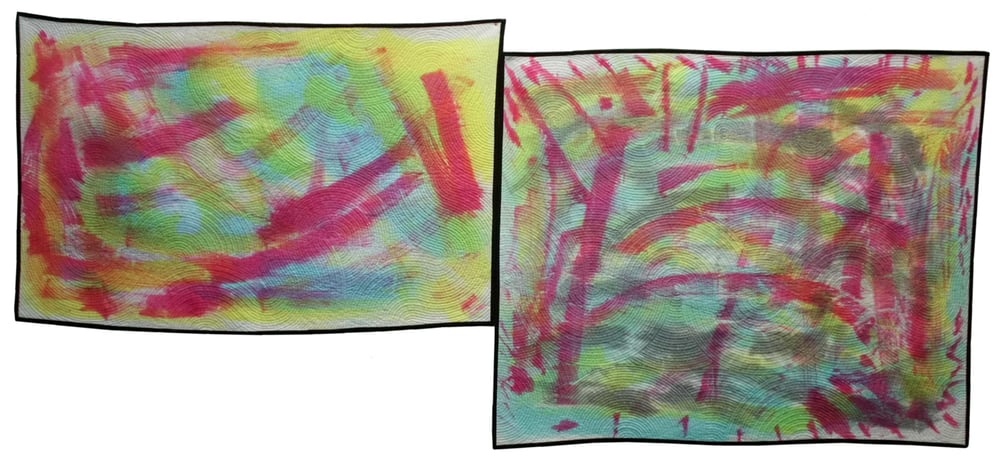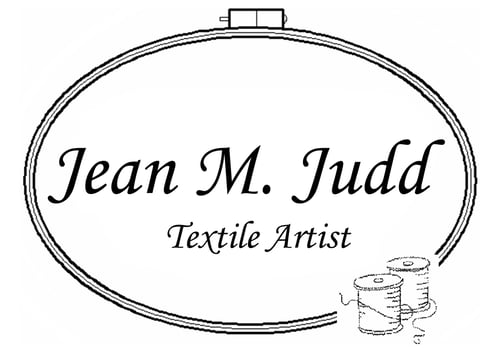Explore my process in hand dyeing, dye painting and rust pigmentation
Welcome to the Process
Each piece that I create, whether it is for a client commission, a design for an upcoming exhibition, or just exploring a particular concept in general, involves a different process. The one aspect that ties all my work together is that they are all made from 100% cotton fabric. This fabric can be commercially printed fabrics, my own hand dyed and rust pigmented fabrics, or recycled clothing and material found at farm auctions. To see more on how I create rust pigmented fabrics you can check the Rust Dyeing Process or Architectural Rust Dyeing page.
This section will show a few examples of part of textile artist Jean M. Judd's process in constructing various pieces, and is not meant to be a tutorial, just a glimpse into one artist's way of constructing a piece. There are no right or wrong ways, and each artist has a process that works for them.
Many can draw out complex designs with ease, and quickly replicate them in fabric. I am not one of those artists. I've been told many times to stick with fabric as my art medium, as my art quilts are fantastic. My stick figures drawn for young children need explanation quite often, and I have a difficult time translating what I "see" in my mind onto paper.

Abstract Textures Installation:
As I was completing Abstract Textures 1.3 (on the right side of the image) in June of 2014, I kept having this idea that this particular series of textile artwork might just "link up" into an installation piece. I tried these two pieces to see if the undulating stitching could run from one piece to the other.
As you can see in the detail photo on the left, it does indeed run into the other artwork at major points.
This is exciting to see, and the possibilities are amazing.
I will need to find a much larger blank wall to be able to experiment with joining the completed first three pieces
Retrospection Construction Process:
The 121 blocks of different fabrics were randomly laid out on the design wall and sewed into strips as shown here in the photo to the left. Not rearranging them was the most difficult of placing them onto the design wall.
Next three different pieced borders were added to the pieced center consisting of the donated 5-inch blocks. The design really doesn't look like much of anything at this stage. It is always fun to see how it changes after the slicing apart, twirling, and reconstruction of the area.
After consideration, one more border was added before the pieced section was marked for cutting with a ball point pen. This design is the only one that I construct still using dress maker shears instead of a rotary cutter and ruler. The "modern" equipment just doesn't all for the type of cutting I need to create this twirling design.
The biggest hurdle in this design is keeping everything in the correct order or it won't come out with the pinwheel design. Here I have completely cut out the blocks and am already sewing the individual blocks back into rows. The pinwheels are starting to show now.
This image shows the completed artwork on my design wall prior to it being layered with batting and a unbleached muslin backing. The artwork will be entirely hand quilted with specific designs created for this art quilt. The size at this stage is 104.5"x104.5".
I receive many emails and questions from clients and other art quilters about what materials I prefer for my work. Each fiber artist has their own likes and dislikes. What works well for one, will be the exact opposite for the next artist. I prefer to use polyester batting in my work because I achieve the best consistency with my hand quilting stitch. Using cotton batting for me is more difficult to stitch through by hand and my stitch length is longer than when I use the polyester batting. I also feel I get more depth to my quilting when using the polyester instead of the cotton batting.
For hand quilting, I prefer YLI 100% glazed cotton quilting thread, Coats & Clark hand quilting thread (glace 32% cotton/68% polyester) and Signature 100% cotton glazed hand quilting thread. All three threads are made in the USA. I have tried other hand quilting threads, but they are not as tightly wound as these are and can fray in the eye of the needle and weaken the thread.
All my work is "soft framed" with what is really a traditional double fold quilt binding. Paintings, drawings, and photographs are framed with a wooden or metal frame either made by the artist or purchased from a commercial source. I prefer to keep the flow of my piece within the textile arena, so I don't use traditional art framing consisting of a frame with glass or plexiglass. It breaks that unconscious feeling or pull of wanting to touch the artwork. I like to keep the soft feeling of the artwork. My textile artwork still is very easy to hang as each piece comes with its own hanging system that requires just two nails or screws. It functions well with gallery hanging systems too.
